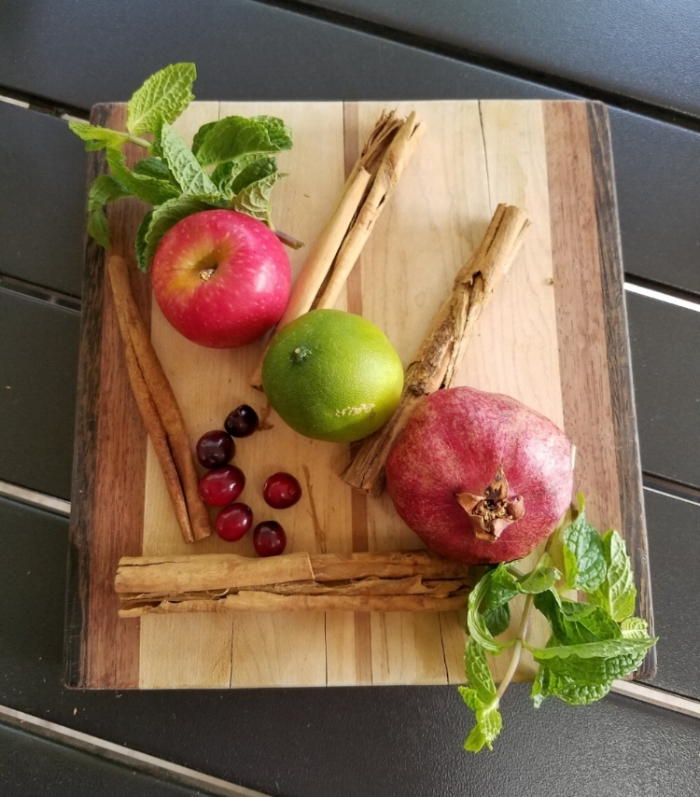Plants and the Signature Cocktail
Let’s talk Signature Cocktails. Aren’t they the first thing you look it on a menu? Being a fan of spirits, I do.
Why not have Signature Cocktails at home, especially for celebration?
I crafted this holiday drink first for Thanksgiving, then realized it would work well all for all the upcoming festive winter holidays.
The Bouncing Berry
The Bouncing Berry:
It’s refreshing, planty, intoxicating and a stunning beauty.
The Bouncing Berry: The Recipe
Add the ingredients to your glass in this order:
Ice
Spirits - 1 shot or more. Your choice of vodka, bourbon, tequila or rum – any pairs well.
Apple cider - ½ - ¾ cup. Don’t use apple juice.
Seltzer – ¼ cup or less. Let your love of bubbles be your guide.
Pomegranate juice – 1 splash or more. Don’t add too much, as the beautiful colors will be overwhelmed by red.
Fresh mint – 1 sprig or several leaves
Lime – 2 round slices
Fresh cranberries - They float, so exciting! And they bounce when you drop them!
Cinnamon stick – 1. This swizzle stick adds sweet spicy fragrance and a brown foil to the bright colors.
Signature Cocktail Sustainability
My Botany focus is on the Angiosperms, the flowering plants that make up most of the plant world.
Plants have organs just as we do, but with different functions. Plant organs include seeds, roots, stems, leaves, flowers and fruits.
How does the Bouncing Berry botanize? And what’s happening globally for its sustainable ingredients?
Apple
This hearty, crunchy fruit gets crushed into cider and the residue is retained, unlike apple juice, which is filtered for clarity.
Apples are Pomes, fruit category which develops from parts of the apple blossom.
Apple Sustainability
Pest resistant varieties of apples held reduce chemical pesticide use, keeping these out of the environment.
Agricultural research on Integrated Pest Management (using bugs to eat harmful bugs) and planting apple trees closer together,
in high density orchards helps preserve land space.
Pomegranate
Pomegranates are in the Hesperidium fruit category which includes oranges, grapefruits, lemons and limes.
Just like their citrus cousins, Pomegranates have dividing sections and a peelable skin. The ruby colored juicy aril surrounds the seeds.
Pomegranate Sustainability
Pomegranate trees are naturally drought tolerant, and orchards go further with water recycling.
Agricultural education is part of passing along these pomegranate water conservation practices for future generations.
Mint
This green, clean tasting leafy garnish comes from any of several varieties.
With distinctive square stems, and jagged edged leaves, mint’s green gives a bold color and geometrical pop to the Bouncing Berry.
The scent and flavor of mint comes from distinctive chemical compounds.
Mint Sustainability
Sustainable growing, farmer involvement and an eye on human equity are the focus of AdvanceMint, a mission launched by the Mars Wrigley Confectionery.
the manufacturer of many gums and sweets. A world view of mint farming works to make natural resources sustainable – soil and water conservation,
plentiful mint harvests, all working to preserve natural resources.
Lime
A lighter green to mint’s deeper hue; this citrus fruit is a Hesperidium like the Pomegranate. It’s sour, bright flavor is from limonene, an essential oil.
Lime Sustainability
Lime and citrus farming practices include water conservation with drip farming, soil conservation and fertilizing with plant compost.
Soil cover by “weeds” can provide soil protection. Limiting fertilizers and growing organically farmed limes reduces potentially harmful chemicals from agricultural ecosystems.
Cranberry
Cranberries are bouncy, shiny, penny sized fruits. They’re an accessory fruit, which unlike other fruits that develop from a flower’s ovary,
they develop from other flower parts. Because cranberries contain an inner air pocket, they float!
This wonderful surprise makes the Bouncing Berry a cocktail influencer.
Cranberry Sustainability
Many Cranberry farms are family owned and span generations. Growing on dry land,
cranberries float when the fields are temporarily flooded during harvest on flooded fields. The water is then returned to its source of rivers and reservoirs.
Cinnamon
The swizzle stick of the Bouncing Berry is from the inner bark of the cinnamon tree.
Though the tree is cut down to cut out and scrape the bark, it’s sustainable as the trees will grow back from the stump.
The inner bark is dried, curling up to a rolled tube that accessorizes the beautiful Bouncing Berry.
Cinnamon Sustainability
The Cinnamomum burmannii is a sustainable crop. Cinnamon trees are harvested about every 10 years.
The trees are cut down, but they grow back from the stump, so they aren’t part of the devastating clear cutting of tropical forests.
Any forest takes in carbon dioxide for photosynthesis, and so helps keep this warming global gas from building up in our atmosphere.



